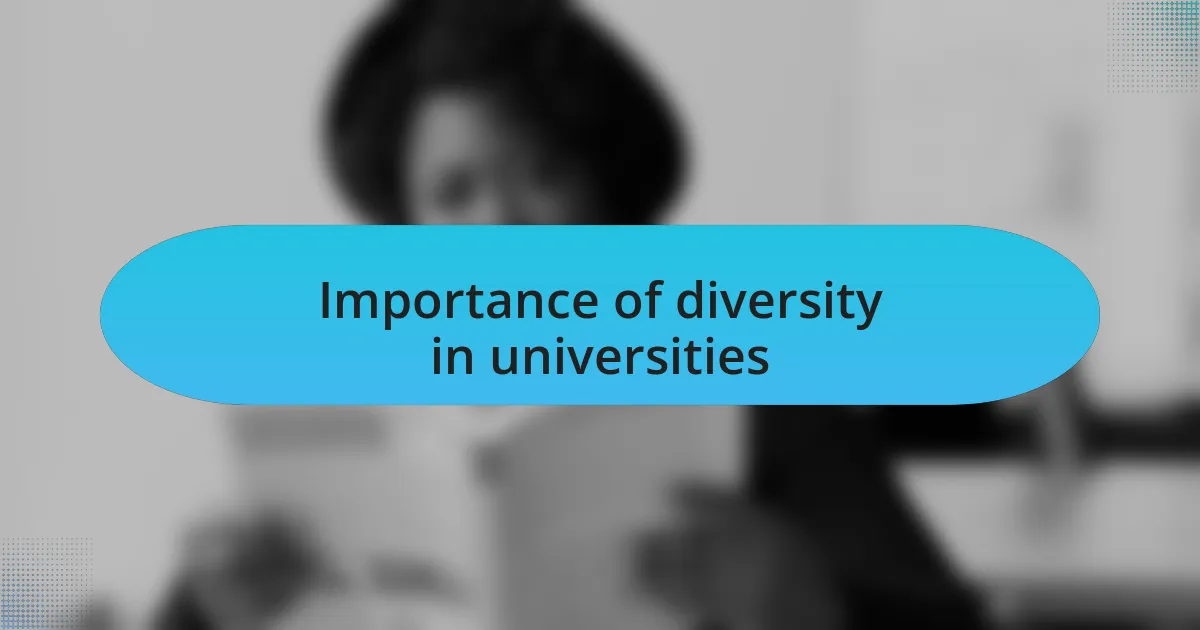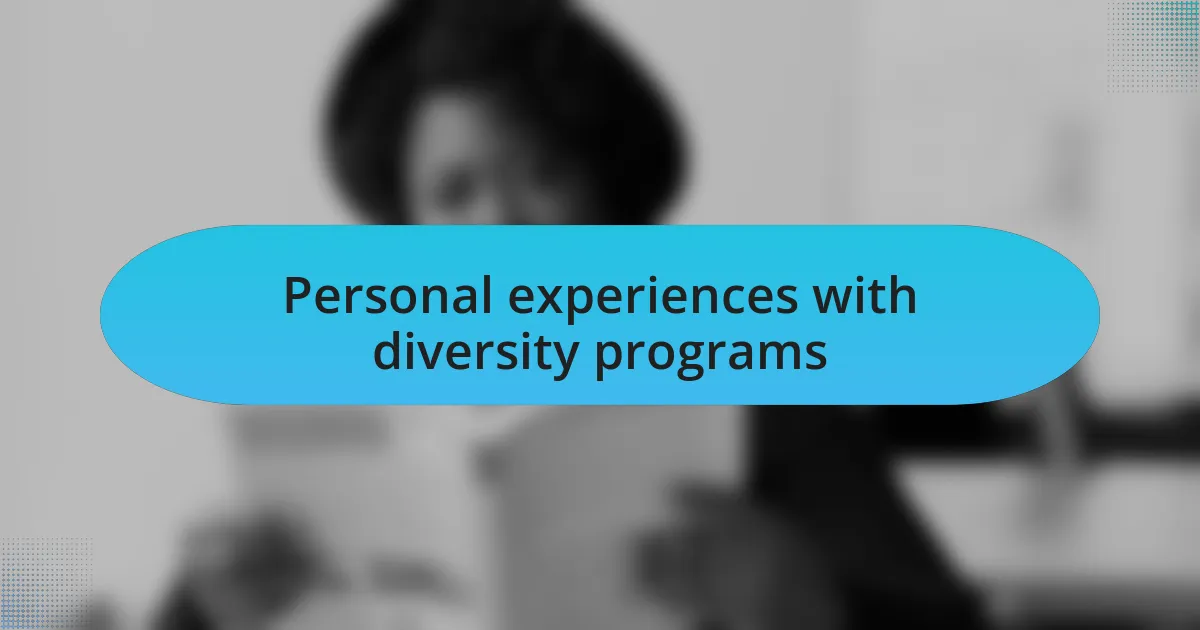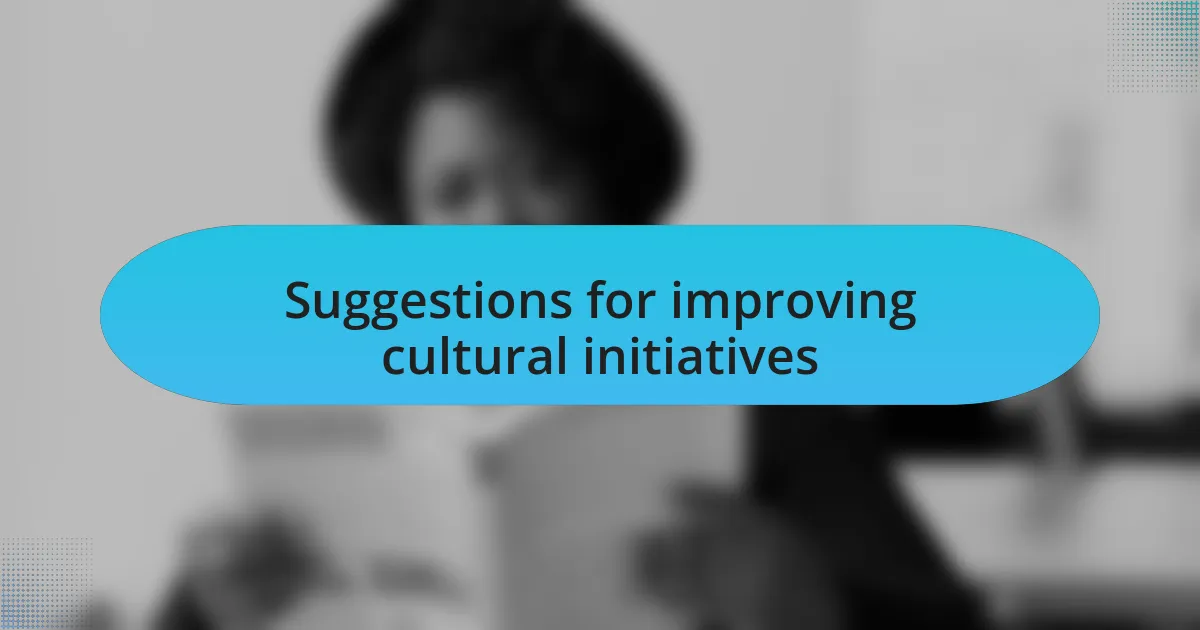Key takeaways:
- Cultural diversity initiatives enhance inclusivity and foster understanding among students from different backgrounds.
- Diversity in universities cultivates empathy, cultural competence, and a sense of belonging, preparing students for a global landscape.
- University student unions play a pivotal role in advocating for underrepresented voices and facilitating connections among diverse student groups.
- Student-led events and ongoing dialogue can significantly improve cultural initiatives, promoting authentic engagement and education about diverse cultures.

Understanding cultural diversity initiatives
Cultural diversity initiatives are fundamental in fostering an inclusive environment in our university settings. I recall a time when I participated in an intercultural exchange program; it opened my eyes to perspectives I had never considered before. What if we could harness that same curiosity among all students?
Understanding the complexities of cultural diversity means recognizing the unique backgrounds, stories, and values each individual brings to the table. I remember feeling a bit out of my element during a cultural awareness workshop, but it was through those uncomfortable moments that I learned to appreciate differences. Have you ever embraced a challenge that ultimately enriched your understanding of others?
These initiatives are not just about checking boxes; they are about creating spaces where everyone can thrive. In my experience, the true magic happens when students from various backgrounds come together and share their experiences. It makes me wonder: how can we encourage more people to engage authentically in these conversations?

Importance of diversity in universities
Diversity in universities is not merely a beneficial aspect; it is essential for preparing students for the global landscape beyond graduation. I recall a group project where my team included students from five different countries. The variety of approaches and solutions we generated was nothing short of inspiring, highlighting how diverse perspectives can lead to innovative outcomes that I never would have imagined alone.
Moreover, maintaining diversity fosters an environment of empathy and cultural competence, which is increasingly vital in our interconnected world. When I participated in discussions facilitated by international students, I found myself not just listening, but truly understanding their realities. Have you ever found that moments of connection, where you empathize with someone different from you, lead to a deeper concern for global issues?
Finally, the presence of diversity helps create a sense of belonging for students from all backgrounds. I remember a time when I attended a multicultural fair on campus; the celebration of our differences made each of us feel valued and included. It begs the question: how do we ensure that every student feels this sense of belonging in their university journey?

Role of university student unions
University student unions play a crucial role in championing diversity initiatives on campus. I remember attending a union-led workshop that focused on cultural awareness. The atmosphere was warm and welcoming, and it prompted me to reflect on my own biases while allowing me to see the world through others’ eyes. Is it surprising how a simple gathering can ignite such profound conversations?
Additionally, student unions serve as key advocates for underrepresented voices, ensuring that all students have a platform. Last semester, I witnessed an initiative where the union organized a series of panels featuring speakers from various cultural backgrounds. This concerted effort not only provided valuable insights but also made many of us feel that our experiences mattered. Isn’t it empowering to know that our unions work to elevate voices that are too often unheard?
Moreover, student unions facilitate connections among diverse student groups, helping foster a sense of community. I once participated in a joint event between the union and cultural groups, where different traditions were presented and celebrated. It was an experience that underscored the power of unity in diversity, leaving me wondering how much richer our campus life could be if these connections were more common.

Personal experiences with diversity programs
During my time at university, I had the opportunity to volunteer with a diversity program that aimed to connect international students with local peers. I still vividly remember the nervous excitement before our first event, where we shared food from our different cultures. The laughter and stories exchanged made me realize how food can bridge gaps and foster understanding—wasn’t it fascinating to taste someone’s background on a plate?
Another memorable experience was participating in a mentorship program focused on underrepresented students. My mentee shared her journey navigating college life as a first-generation student. Hearing her challenges made me reflect on my own experiences and highlighted the importance of supportive relationships in fostering success. It’s moments like these that reaffirm how vital it is to cultivate an inclusive environment.
One of the most eye-opening sessions I attended was a discussion on implicit bias. I went in thinking I understood the concept, but the interactive activities challenged my preconceived notions in unexpected ways. I left the session pondering how many unconscious biases linger in our everyday interactions—could our awareness and actions drive real change on campus?

Suggestions for improving cultural initiatives
Cultural initiatives can improve significantly by incorporating more student-led events. I remember when a group of students organized a cultural showcase that highlighted their unique backgrounds through dance, music, and storytelling. The energy and enthusiasm were palpable, and it reminded me that when students take the lead, the events feel more authentic and resonate deeply with everyone involved. Why not empower students to spearhead these initiatives more regularly?
Another suggestion I have is to create spaces for ongoing dialogue, rather than one-off events. Participating in a weekly cultural exchange series allowed students to share their experiences in a more intimate setting. I found these discussions not only fostered deeper connections but also encouraged a continuous flow of ideas that kept the conversation alive. Wouldn’t it be great if we had regular forums where diverse voices could be heard and celebrated?
Lastly, integrating cultural education into the core curriculum could make a significant impact. I recall a course that explored global perspectives, enhancing my appreciation for different cultures. By weaving cultural topics into academic discussions, we can cultivate a sense of empathy and understanding among all students, enriching the overall learning experience. Shouldn’t our educational journey reflect the diverse world we live in?